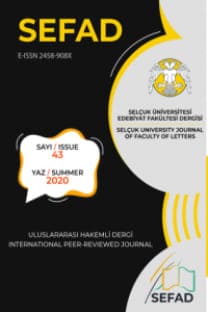DÖVÜŞ KULÜBÜ VE BİR ADAM UYKUDA ESERLERİNDE ERKEK ALANININ KARŞILAŞTIRMALI OLARAK İNCELENMESİ
Dövüş Kulübü, Bir Adam Uykuda, tüketim toplumu
A COMPARATIVE ANALYSIS OF THE MALE SETTING IN THE FIGHT CLUB AND A MAN ASLEEP
The Fight Club, A Man Asleep, culture of consumption,
___
- BAUDRILLARD, Jean (1983). Simulations. New York: Semiotex(e).
- BENJAMIN, Walter (1969). The Work of Art in the Age of Mechanical Reproduction. In Illuminations. trans. H. Zohn. New York: Schocken Books. pp. 219-54.
- BIGNELL, Jonathan (2000). Postmodern Media Culture. Edinbug: Edinburg University Press.
- EAGLETON, Terry (2000). The Idea of Culture. Oxford: Blackwell.
- ECO, Umberto (1987). Casablanca: Cult Movies and Intertextual Collage. In Travels in Hyperreality. trans. W. Weaver. London: Picador. pp. 197-211.
- EWEN, Stuart & EWEN, Elizabeth (1982). Channels of Desire. New York: McGraw-Hill.
- FEATHERSTONE, Mike (1991). Consumer Culture and Postmodernism. London: Sage.
- FOUCAULT, Michael (1986). ‘Of Other Spaces’. In Diacritics (16): 22-27.
- FROSH, Stephen (1987). The Politics of Psychoanalysis: An Introduction to Freudian and Post-Freudian Theory. New Heaven: Yale University Press.
- GOTTDIENER, Mark (1995). Postmodern Semiotics. Material Culture and the Forms of Postmodern Life. Oxford, Blackwell.
- GROSSBERG, Lawrence & Wartella, Ellen et al. (2006). Media Making. Mass Media in a Popular Culture. Sage: Thousand Oaks.
- JAMESON, Frederick (1979). ‘Reification and Utopia in Mass Culture’. Social Text (1): 130-148.
- JAMESON, Frederick (1984). Postmodernism and the Consumer Society. In H. Foster (ed.), Postmodern Culture. London: Pluto Press.
- KRISTEVA, Julia (1987). In the Beginning Was Love; Psychoanalysis and Faith. trans. A. Gold-Hammer. New York: Columbia U.P.
- PALAHNIUK, Chuck (2006). Fight Club. London: Vintage.
- PEREC, George (1990). Things a Story of the Sixties. A Man Asleep. trans. David Bellos and Andrew Leak. Boston: Verba Mundi.
- SCARRY, Elaine (1985). The Body in Pain. The Making and Unmaking of the World. New York: Oxford U.P.
- SONTAG, Susan (2003). Regarding the Pain of Others. New York: Picador.
- SUE, Roger (1991). “Leisure”. Handbook of French Popular Culture. ed. Pierre L Horn. Westport: Greenwood. pp.113-137.
- SUSMAN, Warren (1984). Culture as History. New York: Pantheon.
- WILLIAMS, Raymond (1976). Keywords. London: Fontana.
- Yayın Aralığı: 2
- Başlangıç: 1981
- Yayıncı: Selçuk Üniversitesi Edebiyat Fakültesi
PAUL AUSTER’IN THE MUSIC OF CHANCE ADLI ROMANINDA SINIRLANDIRILMIŞ KAHRAMAN VE ÖZGÜRLÜKTEN KAÇIŞ
DEDE KORKUT HİKÂYELERİNİN ALMANCA ÇEVİRİSİ ÜZERİNE
Neşe UNCU, Zeki USLU, Cem UNCU
KARŞILAŞTIRMALI EDEBİYATTA SA’DÎ VE NÂBÎ’NİN ŞİİRLERİNİN İNCELENİP ARAŞTIRILMASI
Homeyra ZOMORRODI, Diyadin AZARAK
KARAGÖZ VE HACİVAT: BAŞKALDIRI VE İTAATİN YANSIMALARI
MERKEZ-ÇEVRE DÜALİZMİ BAĞLAMINDA TAŞRANIN ONTO-POLİTİK DOĞASI ÜZERİNE ÇIKARIMLAR
EDEBİYATA EKOELEŞTİREL YAKLAŞIMLAR: EKOŞİİR VE ELİF SOFYA
Meliz ERGİN, Özen Nergis DOLCEROCCA
DORIS LESSING’İN CLEFT ADLI ROMANINDA ATAERKİL İÇERİMLER
NESÎMÎ’NİN “SENDEN DÖNMEZEM” REDİFLİ GAZELİNE ESTETİK BİR YAKLAŞIM
